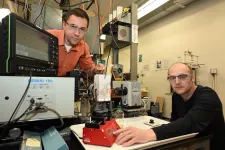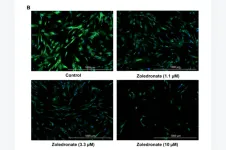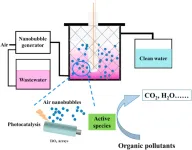(Press-News.org) UPTON, NY—Hydrogen, the simplest element on Earth, is a clean fuel that could revolutionize the energy industry. Accessing hydrogen, however, is not a simple or clean process at all. Pure hydrogen is extremely rare in nature, and practical methods to produce it currently rely on fossil fuels. But if scientists find the right chemical catalyst, one that can split the hydrogen and oxygen in water molecules apart, pure hydrogen could be produced from renewable energy sources such as solar power.
Now, scientists are one step closer to finding that catalyst. Chemists at the University of Kansas and the U.S. Department of Energy’s (DOE) Brookhaven National Laboratory have unraveled the entire reaction mechanism for a key class of water-splitting catalysts. Their work was published today in Proceedings of the National Academy of Sciences (PNAS).
“It’s very rare that you can get a complete understanding of a full catalytic cycle,” said Brookhaven chemist Dmitry Polyansky, a co-author of the paper. “These reactions go through many steps, some of which are very fast and cannot be easily observed.”
Rapid intermediate steps make it difficult for scientists to decipher exactly where, when, and how the most important parts of a catalytic reaction occur—and therefore, if the catalyst is suitable for large-scale applications.
At the University of Kansas, associate professor James Blakemore was researching possible candidates when he noticed something unusual about one catalyst in particular. This catalyst, called a pentamethylcyclopentadienyl rhodium complex, or Cp*Rh complex, was demonstrating reactivity in an area where molecules are usually stable.
“Metal complexes—molecules that contain a metal center surrounded by an organic scaffold—are important for their ability to catalyze otherwise difficult reactions,” said Blakemore, who is also a co-author of the paper. “Typically, reactivity happens directly at the metal center, but in our system of interest, the ligand scaffold appeared to directly take part in the chemistry.”
So, what exactly was reacting with the ligand? Was the team really observing an active step in the reaction mechanism or just an undesirable side reaction? How stable were the intermediate products that were produced? To answer questions like these, Blakemore collaborated with chemists at Brookhaven Lab to use a specialized research technique called pulse radiolysis.
Pulse radiolysis harnesses the power of particle accelerators to isolate rapid, hard-to-observe steps within a catalytic cycle. Brookhaven’s Accelerator Center for Energy Research (ACER) is one of only two locations in the United States where this technique can be conducted, thanks to the Lab’s advanced particle accelerator complex.
“We accelerate electrons, which carry significant energy, to very high velocities,” said Brookhaven chemist David Grills, another co-author of the paper. “When these electrons pass through the chemical solution we’re studying, they ionize the solvent molecules, generating charged species that are intercepted by the catalyst molecules, which rapidly alter in structure. We then use time-resolved spectroscopy tools to monitor the chemical reactivity after this rapid change occurs.”
Spectroscopic studies provide spectral data, which can be thought of as the fingerprints of a molecule’s structure. By comparing these signatures to known structures, scientists can decipher physical and electronic changes within the short-lived intermediate products of catalytic reactions.
“Pulse radiolysis allows us to single out one step and look at it on a very short timescale,” Polyansky said. “The instrumentation we used can resolve events at one millionth to one billionth of a second.”
By combining pulse radiolysis and time-resolved spectroscopy with more common electrochemistry and stopped-flow techniques, the team was able to decipher every step of the complex catalytic cycle, including the details of the unusual reactivity occurring at the ligand scaffold.
“One of the most remarkable features of this catalytic cycle was direct involvement of the ligands,” Grills said. “Often, this area of the molecule is just a spectator, but we observed reactivity within the ligands that had not yet been proven for this class of compounds. We were able to show that a hydride group, an intermediate product of the reaction, jumped onto the Cp* ligand. This proved that the Cp* ligand was an active part of the reaction mechanism.”
Capturing these precise chemical details will make it significantly easier for scientists to design more efficient, stable, and cost-effective catalysts for producing pure hydrogen.
The researchers also hope their findings will provide clues for deciphering reaction mechanisms for other classes of catalysts.
“In chemistry, findings like ours can often be generalized and applied to optimize other systems, but obtaining critical details on rapid reactivity, like we have done here, is a key step,” Blakemore said. “We hope other research groups will take our insights and build on them, perhaps by using ligand-promoted reactivity to build better catalysts.”
This study is just one set of experiments among a large body of clean energy work that scientists at the University of Kansas and Brookhaven Lab are conducting.
“We’re building the fundamental chemical knowledge that will, one day, help scientists design the optimal catalyst for producing pure hydrogen,” Polyansky said.
This work was supported by the National Science Foundation and the DOE Office of Science.
Brookhaven National Laboratory is supported by the Office of Science of the U.S. Department of Energy. The Office of Science is the single largest supporter of basic research in the physical sciences in the United States and is working to address some of the most pressing challenges of our time. For more information, visit science.energy.gov.
Follow @BrookhavenLab on Twitter or find us on Facebook.
END
Chemists unravel reaction mechanism for clean energy catalyst
Pulse radiolysis experiments at Brookhaven Lab revealed rapid reactivity that has never been observed before
2023-05-16
ELSE PRESS RELEASES FROM THIS DATE:
Effects of zoledronic acid on senescence and SASP markers
2023-05-16
“In the present study, we used multiple complementary approaches to evaluate the possible effects of zoledronic acid on cellular senescence.”
BUFFALO, NY- May 15, 2023 – A new research paper was published on the cover of Aging (listed by MEDLINE/PubMed as "Aging (Albany NY)" and "Aging-US" by Web of Science) Volume 15, Issue 9, entitled, “In vitro and in vivo effects of zoledronic acid on senescence and senescence-associated secretory phenotype markers.”
Zoledronic acid has been found to reduce fracture ...
Automated agricultural machinery requires new approaches to ensuring safety
2023-05-16
URBANA, Ill. — From self-driving tractors to weeding robots and AI-powered data collection, automated machinery is revolutionizing agricultural production. While these technological advancements can greatly improve productivity, they also raise new questions about safety measures and regulations. To address these issues, a recent study from the University of Illinois reviewed current academic literature on the safety of automated agricultural machines. Based on a review of more than 60 papers, the researchers identified three ...
Experts say it’s not yet time to take off masks in the health care setting
2023-05-16
1. Experts say it’s not yet time to take off masks in the health care setting
Abstract: https://www.acpjournals.org/doi/10.7326/M23-1190
URL goes live when the embargo lifts
A new commentary from infectious disease experts at George Washington University School of Medicine and the National Institutes of Health (NIH) says for patient safety, masking should continue in health care settings. This message conflicts with a recent commentary from authors from 8 U.S. institutions suggesting that the time for universal masking is over. The commentary is published in Annals of Internal Medicine.
Masking has been a controversial ...
The number of the world's farms to halve by 2100, study shows
2023-05-16
New University of Colorado Boulder research shows the number of farms globally will shrink in half as the size of the average existing farms doubles by the end of the 21st century, posing significant risks to the world’s food systems.
Published today in the journal Nature Sustainability, the study is the first to track the number and size of farms year-over-year, from the 1960s and projecting through 2100.
The study shows that even rural, farm-dependent communities in Africa and Asia will experience a drop in the number of operating farms.
“We see a turning point from widespread farm creation to widespread consolidation on a global level, and that's ...
Investigation raises questions over lack of “substantial evidence” for FDA approved antibiotic
2023-05-16
Drugs approved in the US require “substantial evidence” that they are effective. But an investigation by The BMJ into the recent approval of the antibiotic Recarbrio from Merck suggests that these standards are being bypassed.
Peter Doshi, senior editor at The BMJ, describes how US Food and Drug Administration (FDA) scientists had serious doubts about Recarbrio - a product 40 times more expensive than an existing generic alternative - but the agency approved it anyway.
Did the FDA break its own rules in approving this antibiotic, and what does this case tell us about problems within the agency, he asks?
Recarbrio is a combination therapy made up ...
Chemical exposure may raise your risk for Parkinson’s
2023-05-16
Two years of heavy exposure to TCE, a liquid chemical that lingers in the air, water and soil, may increase the risk of Parkinson’s disease by 70%.
Previous research has linked TCE, or trichloroethylene, to certain cancers, but a new study publishing in JAMA Neurology on May 15, 2023, is believed to be the first large-scale study to demonstrate its association with Parkinson’s.
TCE has been used for industrial and commercial purposes for nearly 100 years, and was used ...
How old are your bones?
2023-05-16
Researchers from The University of Technology Sydney (UTS) have measured the extent to which a bone fracture can lead to early death, and created a publicly available tool that doctors and patients can use to calculate risk.
The research, ‘Skeletal Age’ for mapping the impact of fracture on mortality has just been published in the prestigious scientific journal, eLife.
In the study of more than 1.6 million adults, the scientists found that a bone fracture was associated with a loss of one to ...
IU researchers find link between obesity and blood cancer
2023-05-16
Indiana University School of Medicine researchers studying clonal hematopoiesis of indeterminate potential (CHIP), a blood condition that may increase the risk of blood cancer, discovered that obesity was strongly associated with the condition. Their findings were recently published in the Journal of Clinical Investigation.
CHIP is a condition where blood cells accumulate genetic mutations, increasing the risk of developing blood cancer. Although CHIP is common in aging, the risk factors that contribute to the condition are poorly understood.
“Our study’s results showed being overweight ...
Degradation of Rhodamine B in the photocatalytic reactor containing TiO2 nanotube arrays coupled with nanobubbles
2023-05-16
The study is led by Xiaojun Han (School of Chemistry and Chemical Engineering, Harbin Institute of Technology).
With the rapid development of urbanization and industrialization, environmental problems became increasingly serious. Dye wastewater is considered to be one of the biggest challenges due to its high toxicity. Organic dyes have mutagenic, teratogenic, and carcinogenic properties, and threaten the health and life of humans while hindering plant photosynthesis, which brings risks to the ecosystem. Traditional organic pollutant treatment ...
Occasional cannabis use during pregnancy may be enough to impact fetal growth significantly
2023-05-16
As more people use cannabis for recreational purposes, attitudes towards the drug have changed. For example, research has shown that dispensaries often recommend cannabis – also referred to as marijuana – to pregnant women to ease pregnancy symptoms, especially morning sickness.
There is a growing body of literature attesting to poor child outcomes if cannabinoids are consumed during pregnancy. The exact effects on the developing fetus, however, remain unclear. Researchers in the US have now examined how timing of cannabis exposure during pregnancy impacts fetal development.
“We show that even when marijuana use occurred only ...
LAST 30 PRESS RELEASES:
How talking slows eye movements behind the wheel
The Ceramic Society of Japan’s Oxoate Ceramics Research Association launches new international book project
Heart-brain connection: international study reveals the role of the vagus nerve in keeping the heart young
Researchers identify Rb1 as a predictive biomarker for a new therapeutic strategy in some breast cancers
Survey reveals ethical gaps slowing AI adoption in pediatric surgery
Stimulant ADHD medications work differently than thought
AI overestimates how smart people are, according to HSE economists
HSE researchers create genome-wide map of quadruplexes
Scientists boost cell "powerhouses" to burn more calories
Automatic label checking: The missing step in making reliable medical AI
Low daily alcohol intake linked to 50% heightened mouth cancer risk in India
American Meteorological Society announces Rick Spinrad as 2026 President-Elect
Biomass-based carbon capture spotlighted in newly released global climate webinar recording
Illuminating invisible nano pollutants: advanced bioimaging tracks the full journey of emerging nanoscale contaminants in living systems
How does age affect recovery from spinal cord injury?
Novel AI tool offers prognosis for patients with head and neck cancer
Fathers’ microplastic exposure tied to their children’s metabolic problems
Research validates laboratory model for studying high-grade serous ovarian cancer
SIR 2026 delivers transformative breakthroughs in minimally invasive medicine to improve patient care
Stem Cell Reports most downloaded papers of 2025 highlight the breadth and impact of stem cell research
Oxford-led study estimates NHS spends around 3% of its primary and secondary care budget on the health impacts of heat and cold in England
A researcher’s long quest leads to a smart composite breakthrough
Urban wild bees act as “microbial sensors” of city health.
New study finds where you live affects recovery after a hip fracture
Forecasting the impact of fully automated vehicle adoption on US road traffic injuries
Alcohol-related hospitalizations from 2016 to 2022
Semaglutide and hospitalizations in patients with obesity and established cardiovascular disease
Researchers ‘listen in’ to embryo-mother interactions during implantation using a culture system replicating the womb lining
How changing your diet could help save the world
How to make AI truly scalable and reliable for real-time traffic assignment?
[Press-News.org] Chemists unravel reaction mechanism for clean energy catalystPulse radiolysis experiments at Brookhaven Lab revealed rapid reactivity that has never been observed before



